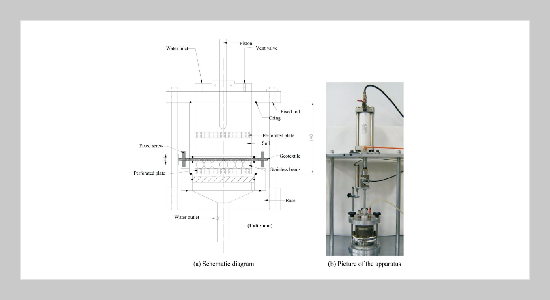REFERENCES
- [1] Bell, A. L., McCullough, L. M. and Snaith, M. S., “An Experimental Investigation of Sub-Base Protection Using Geotextiles,” Proceedings of the 2nd International Conference on Geotextiles, Las Vegas, Vol. 1, pp. 435�440 (1982).
- [2] Hoare, D. J., “A Laboratory Study into Pumping Clay through Geotextiles under Dynamic Loading,” Proceedings of the 2nd International Conference on Geotextiles, Las Vegas, Vol. 1, pp. 423�428 (1982).
- [3] Floss, R., Laier, H. and Brau, G., “Dynamic Loading of Geotextile/Soil Systems,” Proceedings of the 4th International Conference on Geotextiles, Geomembranes and Related Products, Hague, Netherlands, Vol. 1, pp. 183�188 (1990).
- [4] Saxena, S. K. and Hsu, T. S., “Permeability of Geotextile-Included Railroad Bed under Repeated Load,” Geotextiles and Geomembranes, Vol. 4, pp. 31�51 (1986).
- [5] Lafleur, J., Rollin, A. L. and Mlynarek, J., “Clogging of Geotextiles under Pumping Loads,” Proceedings of the 4th International Conference on Geotextiles, Geomembranes and Related Products, Hague, Netherlands, Vol. 1, pp. 189�192 (1990).
- [6] McMorrow, J., “Filtering Action of Non-Woven Geotextiles under Dynamic Loading,” Proceedings of the 4th International Conference on Geotextiles, Geomembranes and Related Products, Hague, Netherlands, Vol. 1, pp. 233�238 (1990).
- [7] Narejo, D. B. and Koerner, R. M., “A Dynamic Filtration Test for Geotextile Filters,” Geotextiles and Geomembranes, Vol. 11, pp. 395�400 (1992).
- [8] Lafleur, J., Assi, M. and Mlynarek, J., “Behavior of Nonwoven Geotextiles under Pumping Loads,” Recent Developments in Geotextile Filters and Prefabriced Drainage Geocomposites, ASTM, STP 1281, Bhatia & Suits (Eds.), American Society for Testing and Materials, pp. 211�221 (1996).
- [9] Fourie, A. B. and Kuchena, S. M., “The Influence of Tensile Stresses on the Filtration Characteristics of Geotextiles,” Geosynthetics International, Vol. 2, pp. 455�471 (1995).
- [10] Fourie, A. B. and Addis, P. C., “The Effect of In-Plane Tensile Loads on the Retention Characteristics of Geotextiles,” Geotechnical Testing Journal, GTJODJ, Vol. 20, pp. 211�217 (1997).
- [11] Fourie, A. B. and Addis, P. C., “Changes in Filtration Opening Size of Woven Geotextiles Subjected to Tensile Loads,” Geotextiles and Geomembranes, Vol. 17, pp. 331�340 (1999).
- [12] Wu, C. S., Hong, Y. S. and Wang, R. H., “The Influence of Uniaxial Tensile Strain on the Pore Size and Filtration Characteristics of Geotextiles,” Geotextiles and Geomembranes, Vol. 26, pp. 250�262 (2008).
- [13] Wu, C. S., Hong, Y. S., Yan, Y. W. and Chang, B. S., “Soil-Nonwoven Geotextile Filtration Behavior under Contact with Drainage Materials,” Geotextiles and Geomembranes, Vol. 24, pp. 1�10 (2006).
- [14] Kozeny, J., “Ueber Kapillare Leitung des Wassers im Boden,” Wien, Akad. Wiss., Vol. 136, p. 271 (1927).
- [15] Carman, P. C., “The Determination of the Specific Surface of Powders,” J. Soc. Chem. Ind. Trans., Vol. 57, p. 225 (1938).
- [16] Carman, P. C., “Flow of Gases through Porous Media,” Butterworths Scientific Publications, London (1956).
- [17] Carrier III, W. D., “Good by, Hazen; Hello, KozenCarman,” Journal of Geotechnical and Geoenvironmental Engineering, ASCE, Vol. 129, pp. 1054�1056 (2003).
- [18] Chapuis, R. P., “Predicting the Saturated Hydraulic Conductivity of Sand and Gravel Using Effective Diameter and Void Ratio,” Canadian Geotechnical Journal, Vol. 41, pp. 787�795 (2004).
- [19] Palmeira, E. M., Gardoni, M. G. and Bessa da Luz, D. W., “Soil-Geotextile Filter Interaction under High Stress Levels in the Gradient Ratio Test,” Geosynthetics International, Vol. 12, pp. 162�175 (2005).
- [20] Snaith, M. S. and Bell, A. L., “The Filtration Behavior of Construction Fabrics under Conditions of Dynamic Loadings,” Geotechnique, Vol. 28, pp. 466�468 (1978).









